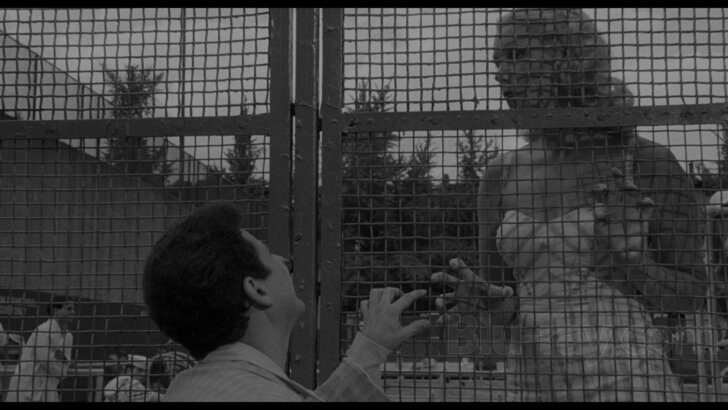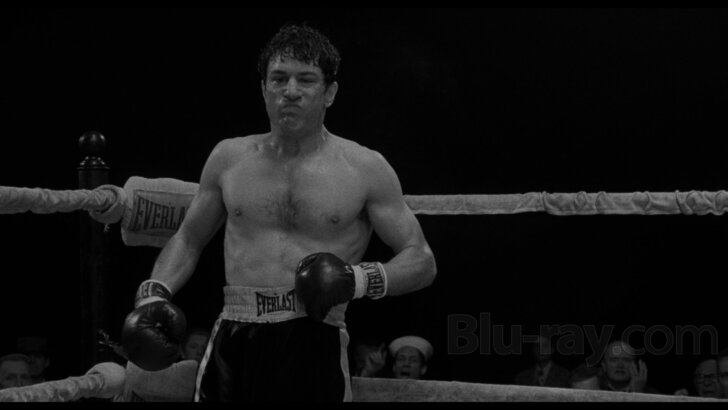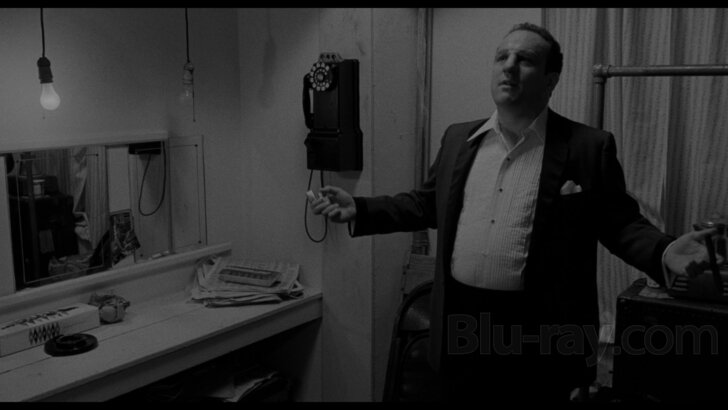Raging Bull 4K Blu-ray Movie
HomeRaging Bull 4K Blu-ray Movie 
4K Ultra HD + Blu-rayCriterion | 1980 | 129 min | Rated R | Jul 12, 2022
Movie rating
8.5 | / 10 |
Blu-ray rating
| Users | 4.8 | |
| Reviewer | 5.0 | |
| Overall | 4.8 |
Overview
Raging Bull 4K (1980)
The story of Jake LaMotta, a former middleweight boxing champion, whose reputation for tenacity and success in the ring was offset by his troubled domestic life: full of rage, jealousy, and suspicion—particularly towards his wife and manager/brother—which, in the end, left him destitute, alone, and seeking redemption.
Starring: Robert De Niro, Cathy Moriarty, Joe Pesci, Frank Vincent, Nicholas ColasantoDirector: Martin Scorsese
| Drama | Uncertain |
| Biography | Uncertain |
| Sport | Uncertain |
Specifications
Video
Video codec: HEVC / H.265
Video resolution: 4K (2160p)
Aspect ratio: 1.85:1
Original aspect ratio: 1.85:1
Audio
English: DTS-HD Master Audio 2.0 (48kHz, 24-bit)
Subtitles
English SDH
Discs
Blu-ray Disc
Two-disc set (2 BDs)
4K Ultra HD
Playback
Region A (locked)
Review
Rating summary
| Movie | 5.0 | |
| Video | 5.0 | |
| Audio | 5.0 | |
| Extras | 5.0 | |
| Overall | 5.0 |
Raging Bull 4K Blu-ray Movie Review
Reviewed by Dr. Svet Atanasov June 8, 2022Martin Scorsese's "Raging Bull" (1980) arrives on 4K Blu-ray courtesy of Criterion. The supplemental features on the release include three vintage audio commentaries; multiple archival programs featuring Martin Scorsese and cast members; two video essays; vintage trailer for the film; and more. In English, with optional English SDH subtitles for the main feature. Region-Free.

The Bronx Bull
To say that Jake LaMotta a.k.a. The Bronx Bull had an eventful life would be a major understatement. After growing up as a serious troublemaker in the Bronx slums (and Philadelphia), LaMotta began making ends meet as a boxer and in 1943 became a national sensation when he handed Sugar Ray Robinson his first-ever defeat. Soon after, he was crowned middleweight champion twice. On the way up, LaMotta made a lot of money -- some of it legally, some of it illegally -- but did not manage his earnings right, spent too much time with the wrong guys, and risked losing nearly everything. He retired in 1954, moved to Miami, and for a while managed a nightclub where he got into more trouble that eventually forced him to try his luck as a stand-up comedian. Throughout his life, LaMotta married multiple times and always kept an active public profile, but in the end passed away alone in a nursing home in Aventura, Florida, at the age of 95.
Marty Scorsese’s film Raging Bull enters LaMotta’s world with impressive authority, but it does not take long to figure out that even with Robert De Niro’s iconic transformation, it remains a bit too kind to the late boxer. To a certain extent, this isn’t surprising because Scorsese began shooting after Paul Schrader had adapted LaMotta’s autobiographical novel, meaning that the bulk of the original material obviously comes from it, but towards the end, the intent to present a more balanced depiction of the boxer’s deterioration becomes a bit too obvious. Is it possible that this was the only way Raging Bull could have been made? Yes. In fact, it is guaranteed that it was the only way because LaMotta was apparently consulted even after the screenplay was delivered to Scorsese and he had started shooting.
So, who was the real LaMotta?
De Niro’s terrific performance makes it very easy to guess -- he was a borderline unhinged bully hiding in the body of a gifted boxer, the type of perpetual abuser that would attack even the few people who tried to love him. It is precisely why Scorsese places as much emphasis on LaMotta’s rocky, often unusually violent relationships with his wife, Vicki (Cathy Moriarty), and brother, Joey (Joe Pesci), as he does on his wins and losses in the ring. Violence was what helped LaMotta understand the real world and remain viable in it.
But it was violence that also ruined LaMotta. In Raging Bull, the crucial moment where his downfall is initiated comes after LaMotta accuses Vicki of having an affair with Joey and then tries to hurt both. Everything changes after that because it is only a matter of time before both effectively remove him from their lives, and he begins to self-destruct. The real LaMotta apparently quickly realized his mistake and repeatedly tried to lure them back into his world, but it never worked, and he died with a broken heart.
It is said that the real LaMotta had to see Raging Bull to finally grasp what an awful person he had been over the years, but this is almost certainly one of those stories that just sound good and help with publicity. Why? Because LaMotta did not become an awful person after his boxing career took off and he met Vicki, which is where Raging Bull begins. The real LaMotta grew up surrounded by sketchy characters, spent time in a reform school, and very much enjoyed being an awful person. It is why in 1970, after his guilt had begun consuming him, he described his life in a novel.
*Criterion’s upcoming 4K Blu-ray and Blu-ray releases present an exclusive new 4K restoration of Raging Bull that was supervised and approved by Scorsese.
Raging Bull 4K Blu-ray Movie, Video Quality 

4K BLU-RAY DISC
Criterion's release of Raging Bull is a 4K Blu-ray/Blu-ray combo pack.
The following text appears inside the booklet that is provided with this release:
"Approved by director Martin Scorsese, this new master was created in 4K resolution on a Lasergraphics Director film scanner from the 35mm original camera negative. The original 2.0 surround soundtrack was remastered from the 35mm three-track magnetic track. Please be sure to enable Dolby Pro Logic Decoding on your receiver to properly play the 2.0 surround soundtrack On the 4K Blu-ray disc, the feature is presented in HDR (high dynamic range). On the Blu-ray, it is presented in high-definition SDR (standard dynamic range).
Transfer supervisor: Martin Scorsese, Thelma Schoonmaker.
Colorist: Gregg Garvin/Roundabout Entertainment, Burbank, CA."
Please note that all screencaptures that appear with this article are taken from the 4K Blu-ray and are downscaled to 1080p. Therefore, they do not accurately reflect the quality of the 4K content on the 4K Blu-ray disc, including the actual values and balance of the grayscale.
The only other release of Raging Bull that I have in my library is this Region-B release, which should be identical to the one MGM produced for the North American market in 2009. So, after viewing the 4K and 1080p presentations last night and today, I did plenty of direct comparisons.
First, I have to say that the old release still offers a pretty nice and healthy organic presentation of Raging Bull. I think that the visuals still hold up quite well or a larger screen as well. However, the new 4K restoration offers a range of different improvements that give the entire film an all-around superior organic appearance that is extremely similar to the one we witnessed with the 4K makeover of Billy Wilder's Some Like It Hot. Obviously, Raging Bull has a different stylistic appearance, but the type of qualities we analyze in our reviews reveal the same strong organic characteristics. For example, despite the native density fluctuations, the black-and-white footage reveals better grain exposure and, in many areas, clearly improved delineation. (The exceptions are the announcement shots and the colored 'vintage' footage). All of this footage looks sharper in native 4K as well -- not digitally sharpened, but naturally sharper. The HDR grade makes a substantial difference, too. Indeed, when compared to their counterparts from the previous release, virtually all visuals now boast an overall better dynamic range, with blacks and grays looking particularly impressive. Also, these improvements in the dynamic range remain rather remarkably consistent during daylight and darker/nighttime footage. Depth is better. The boxing footage looks most impressive now because backgrounds benefit a lot from a combination of things, so the improvements are everywhere, not in a particular area. Fluidity is excellent in native 4K, but I must point out that on the 1080p presentation, it is equally impressive. Rather predictably, there are absolutely no traces of age-related anomalies to report. All in all, I think that the new 4K makeover is quite striking, and when experienced in native 4K, it absolutely becomes the definitive presentation of Raging Bull. (Note: The 4K Blu-ray release is Region-Free).
BLU-RAY DISC
The biggest and most obvious discrepancy between the 1080p and native 4K presentations of the new 4K restoration emerges from the superior dynamic range of the visuals in native 4K. It is quite obvious. It is my personal opinion that it affects the perception of depth, clarity, and sharpness in ways that basically give Raging Bull an even more convincing organic appearance. Does the 1080p presentation still look gorgeous? Yes, absolutely, but in native 4K everything looks more finessed, perhaps even more filmic. The transitions from the boxing footage to the regular footage were where I noticed some of the most obvious 'loosening' in the 1080p presentation, but trained eyes will almost certainly identify other areas where the 4K presentation clearly performs better. (Note: This is a Region-A "locked" Blu-ray release. Therefore, you must have a native Region-A or Region-Free player in order to access its content).
Raging Bull 4K Blu-ray Movie, Audio Quality 

There is only one standard audio track on this release: English DTS-HD Master Audio 2.0. Optional English SDH subtitles are provided for the main feature.
I did some random comparisons between the lossless track from the old Blu-ray release and this DTS-HD Master Audio 2.0 track and if there are any areas with dramatic discrepancies between the two, I clearly missed them. I think that the DTS-HD Master Audio 2.0 track handles the original sound design of Raging Bull exceptionally well and is very healthy. Is it possible that one of these new Dolby Atmos track could have done a better job? I doubt it. On my system, everything sounded as good as I think it could be.
Raging Bull 4K Blu-ray Movie, Special Features and Extras 

4K BLU-RAY DISC
- Commentary One - this archival audio commentary features director Martin Scorsese and editor Thelma Schoonmaker. It was recorded in 1990 and appeared on Criterion's LD release of Raging Bull. The bulk of the information that is shared in it addresses the genesis of Raging Bull, its stylistic appearance, and Robert De Niro's passion for the project, as well as the real Jake LaMotta and his life story.
- Commentary Two - this archival audio commentary features director of photography Michael Chapman, producer Robert Chartoff and Irwin Winkler, casting director Cis Corman, music consultant Robbie Robertson, actors Teresa Saldana and John Turturo, and supervising sound effects editor Frank Warner. The commentary was recorded for MGM in 2004. Similar to the first commentary, it offers a wealth of information about the conception of Raging Bull, Martin Scorsese's handling of the original content from Jake LaMotta's novel, the film's gritty personality, and status as a classic.
- Commentary Three - this archival audio commentary features the real Jake LaMotta with his nephew Jason Lustig and screenwriters Mardik Martin and Paul Schrader. The commentary was recorded for MGM in 2004. It is a most fascinating commentary because LaMotta describes the real bully/boxer that became a champion and the various mistakes he made over the years.
- Commentary One - this archival audio commentary features director Martin Scorsese and editor Thelma Schoonmaker. It was recorded in 1990 and appeared on Criterion's LD release of Raging Bull. The bulk of the information that is shared in it addresses the genesis of Raging Bull, its stylistic appearance, and Robert De Niro's passion for the project, as well as the real Jake LaMotta and his life story.
- Commentary Two - this archival audio commentary features director of photography Michael Chapman, producer Robert Chartoff and Irwin Winkler, casting director Cis Corman, music consultant Robbie Robertson, actors Teresa Saldana and John Turturo, and supervising sound effects editor Frank Warner. The commentary was recorded for MGM in 2004. Similar to the first commentary, it offers a wealth of information about the conception of Raging Bull, Martin Scorsese's handling of the original content from Jake LaMotta's novel, the film's gritty personality, and status as a classic.
- Commentary Three - this archival audio commentary features the real Jake LaMotta with his nephew Jason Lustig and screenwriters Mardik Martin and Paul Schrader. The commentary was recorded for MGM in 2004. It is a most fascinating commentary because LaMotta describes the real bully/boxer that became a champion and the various mistakes he made over the years.
- Video Essays - presented here are two video essays.
1. Pour Everything In - critic and poet Geoffrey O'Brien addresses the conception and personality of Raging Bull and Martin Scorsese's cinematic style. In English, not subtitled. (26 min).
2. Gloves Off - critic Sheila O'Malley addresses the characterizations in Raging Bull and the evolving environment they are placed in. In English, not subtitled. (18 min).
- "Raging Bull": Fight Night - this four-part documentary takes a closer look at the production of Raging Bull. Included in it are clips from interviews with Martin Scorsese, Robert De Niro, Cathy Moriarty, Joe Pesci, Frank Vincent, director of photography Michael Chapman, and screenwriter Paul Schrader, amongst others. In English, not subtitled.
1. Before the Fight. (26 min).
2. Inside the Ring. (15 min).
3. Outside the Ring. (28 min).
4. After the Fight. (16 min).
- Martin Scorsese and Robert De Niro - presented here are three archival programs that examine Martin Scorsese and Robert De Niro's professional relationship and legacy. The first two were produced for MGM in 2010, while the third features audio excerpts from a Harold Lloyd Master Seminar recorded in 1980 at the American Film Institute.
1. Marty and Bobby. (14 min).
2. Marty on Film. (11 min).
3. Robert De Niro on Acting. (15 min).
- Jake LaMotta - presented here are two archival programs that take a closer look at boxing champion Jake LaMotta. The first includes excerpts from a 1990 interview with LaMotta and boxing footage from his career. The second, produced for MGM in 2010, features members of the Veteran Boxers Association of New York addressing LaMotta's legacy. In English, not subtitled.
1. Jake LaMotta. (6 min).
2. Remembering Jake. (11 min).
- Cathy Moriarty and Vikki LaMotta - this archival interview featuring Cathy Moriarty, who played Vikki LaMotta in Raging Bull, was recorded for Belgian television in 1981. The bulk of the comments address the personality of the real Jake LaMotta and his fear of losing. In English, not subtitled. (8 min).
- Trailer - presented here is a vintage trailer for Raging Bull. In English, not subtitled. (3 min).
- Booklet - an illustrated booklet featuring essays by poet Robin Robertson and film critic Glenn Kenny, as well as technical credits.
Raging Bull 4K Blu-ray Movie, Overall Score and Recommendation 

The real Jake LaMotta was a fearless boxer who fought as hard as he could and endured some absolutely incredible matches. But when he wasn't fighting to make ends meet, he was an awful bully and perpetual abuser, and couldn't get along even with the few people who genuinely loved him and tried to have meaningful parts in his life. Martin Scorsese's Raging Bull has immortalized LaMotta thanks to a truly remarkable performance by Robert De Niro, but it has to be said that this excellent film tells only a fraction of the late boxer's story. Criterion's upcoming 4K Blu-ray release of Raging Bull is sourced from an outstanding exclusive new 4K restoration that was supervised and approved by Scorsese. VERY HIGHLY RECOMMENDED.
Other editions
Raging Bull: Other Editions

Raging Bull
MGM 90th Anniversary
1980

Raging Bull
35th Anniversary Edition
1980

Raging Bull
1980

Raging Bull
30th Anniversary Edition
1980

Raging Bull
1980
Similar titles
Similar titles you might also like

The Irishman
2019

The Fighter
2010

The Wrestler
2008

Phantom Punch
2009

Million Dollar Baby
10th Anniversary Edition
2004

Capone
2020

The Aviator
2004

J. Edgar
2011

I, Tonya
2017

Molly's Game
2017

Hands of Stone
2016

Mean Streets 4K
1973

Her Smell
2018

The Social Network
Collector's Edition
2010

Nixon
Election Year Edition
1995

Tommaso
2019

Lovelace
2013

Citizen Kane
75th Anniversary Edition
1941

The Iron Lady
2011

Sex Madness
1938
